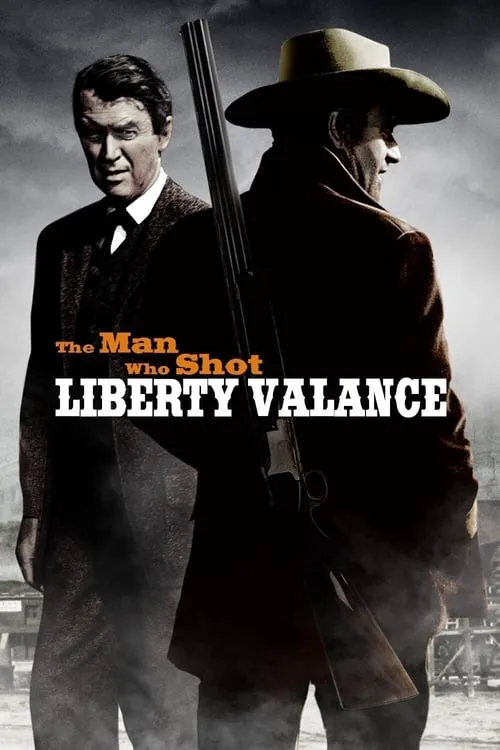The Man Who Shot Liberty Valance

Plot
The Man Who Shot Liberty Valance is a classic Western film released in 1962, directed by John Ford and starring John Wayne, James Stewart, and Lee Marvin. The movie is a thought-provoking exploration of the theme of myth-making and the power of storytelling, set against the backdrop of the Wild West. The film begins with the funeral of Tom Doniphon, a rugged cowhand who saved a young lawyer named Ransom Stoddard from a group of outlaws. Stoddard, now a senator, has arrived at the funeral to pay his respects. However, upon arrival, he is met with suspicion and hostility from the townspeople. They seem to view Stoddard with a mixture of disdain and resentment, and it becomes clear that Doniphon was a revered figure in these parts. As the story flashes back, we see Stoddard's arrival in the small Western town, where he hopes to make a name for himself and bring law and order to the community. However, he quickly learns that the town is terrorized by a ruthless outlaw named Liberty Valance, who roams free and does as he pleases. Valance is a giant of a man, with a menacing presence and a deadly reputation. Meanwhile, Doniphon, a rugged and taciturn cowhand, has a long-standing feud with Valance. Doniphon is the only person who stands up to Valance, and their rivalry has become legendary in the town. Stoddard watches in awe as Doniphon takes on Valance and his gang, but he is also fearful of what might happen to him. As the story unfolds, we see Stoddard struggling to make a name for himself in the town. He is met with resistance and hostility from the townspeople, who view him as an outsider. However, Stoddard is determined to prove himself and eventually, with the help of a local schoolteacher, he manages to win over the trust of the townspeople. However, Doniphon remains the town's protector, and it becomes clear that he is the true hero of the story. Despite his tough exterior, Doniphon has a soft spot for the townspeople, and he genuinely cares for their well-being. He is a tough and rugged man who has seen the worst of humanity, but he also has a strong sense of justice and a desire to protect those who need his help. Meanwhile, Valance remains the villain of the story. He is a cruel and ruthless man who delights in causing pain and suffering. He sees Stoddard as a threat to his power and prestige, and he takes great pleasure in tormenting him. However, Doniphon remains his main target, and their rivalry continues to escalate as the story unfolds. One of the most striking aspects of the movie is its exploration of the theme of myth-making. The townspeople view Doniphon as a hero, but Stoddard knows the truth - that Doniphon was the real hero all along. Stoddard's account of the events at the town, while well-intentioned, does not do justice to the complexity and nuance of what really happened. As the story reaches its climax, Doniphon confronts Valance in a fierce and intense showdown. The outcome is a turning point in the movie, as Doniphon emerges victorious and saves the day. However, the film's final scenes reveal that Stoddard has in fact "sold out" his story and replaced it with a more heroic account of events. In the movie's famous final scene, Stoddard delivers a speech to a crowd of townspeople, proclaiming that he is the one who shot Liberty Valance. However, the townspeople know the truth - that it was Doniphon who made the hero's save. The scene is a poignant commentary on the power of storytelling and the willingness of people to accept a myth in place of the truth. The final scene also raises questions about the nature of heroism and the way that we tell stories about the past. Is it better to tell the truth, no matter how complicated or nuanced it may be? Or is it better to accept a myth that makes heroes out of those who may not have actually deserved it? The Man Who Shot Liberty Valance is a thought-provoking and engaging movie that explores a range of themes and ideas. Its exploration of the nature of heroism, the power of storytelling, and the tension between truth and myth are timeless and relevant today. The movie's themes and ideas have been interpreted in a variety of ways, but ultimately, it is a movie that celebrates the complexity and nuance of human experience. The movie also explores the human cost of living in a violent and unpredictable world. Doniphon's motivations for taking on Valance are not explicitly stated, but it is clear that he is driven by a desire to protect the town and its people. His actions are heroic, but they also come at a great personal cost, and the movie does not shy away from showing the hardships and sacrifices that he makes. John Ford's direction is masterful, and his use of landscape and setting is some of the most iconic in movie history. The movie's climax, which sees Doniphon facing off against Valance in a dusty canyon, is both suspenseful and visually stunning. The film's score, which features a memorable theme by Johnny Mercer, adds to the emotional impact of the movie's final scenes. Overall, The Man Who Shot Liberty Valance is a movie that will continue to resonate with audiences for years to come. Its exploration of heroism, storytelling, and the human condition makes it a timeless classic, and its powerful themes and ideas are still relevant today.
Reviews
Recommendations

